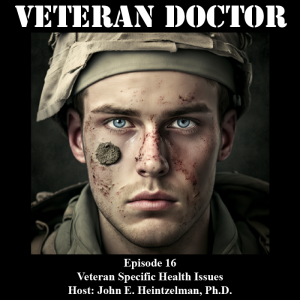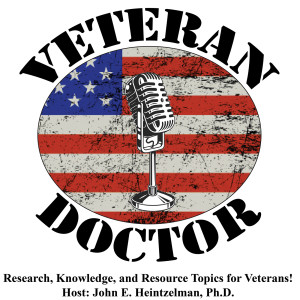
Good Morning Veterans, Family, and Friends, welcome back to the SIXTEENTH EPISODE of the Veteran Doctor. On this week's podcast, we will discuss Veteran Specific Health Issues. We will also continue our fun facts of UBI (Useful Bits of Information) and Veteran News, so stick around for the program!
Hello, fellow veterans! I hope everyone is doing well now that we have been living with COVID for over a year now. Who would have thought this type of thing would come to our society, or world, and make such an impact as it has today? Well, with all of these health-related challenges, what a perfect opportunity to discuss the challenges that veterans face daily that are health-related. Some of you are familiar, some maybe not so knowledgeable, but it is always good to stay up-to-date so that we can help other veterans through their challenges.
Mental health or behavioral adjustment disorders
Medical records of veterans reveal that one in three patients have been diagnosed with at least one mental health disorder – 41% were diagnosed with either mental health or a behavioral adjustment disorder. In compensation or combination with military-related diseases, many veterans develop substance use disorders (SUDs), and a large number ultimately commit suicide. Also, the research found that male veterans diagnosed with depression, manic-depressive disorder, heavy or binge drinking, and alcohol-related problems were significantly associated with an increased risk of suicide. Thus, identifying and treating mental health illness has the most significant potential to mitigate suicide risk. Unfortunately, reluctance to seek help or treatment makes diagnosing and treating mental illness difficult in this population.
SUDs
The stressors of military service increase the risk of veterans having problems with alcohol, tobacco, or drugs. Cigarette smoking and alcohol consumption are higher among veterans than non-military personnel. For some veterans, treatment of a co-morbid condition (e.g., PTSD, depression, pain, insomnia) may resolve the problem.
PTSD
Also known as "shell shock" or "combat fatigue," PTSD results from witnessing or experiencing (directly or indirectly) a traumatic event. PTSD is a combination of symptoms, severity, and duration. Diagnosis is based upon four symptom categories: intrusive symptoms (flashbacks), avoidance of reminders (isolation), negative thoughts and feelings ("no one can be trusted"), and arousal and reactivity symptoms (exaggerated startle response). PTSD is often associated with "traumatic brain injury (TBI), military sexual trauma (MST), sleep problems, substance use, pain, and other psychiatric disorders, and requires comprehensive assessment." Treatment is aimed at therapy (psychotherapy, prolonged exposure therapy, family/group therapy, and others), social support, and/or medication such as antidepressants.
TBI
TBI is a traumatically induced structural injury and/or physiological disruption of brain function due to an external force. TBI can be classified as mild, moderate, or severe depending on the length of unconsciousness, memory loss/disorientation, and responsiveness of the individual following the event (i.e., are they able to follow commands). While mild TBI (or concussion) is the most common, diagnosis is difficult since symptoms include headaches, dizziness/problems walking, fatigue, irritability, memory problems, and problems paying attention.
Depression
Among the available data from the National Alliance on Mental Illness (NAMI), depression ranks among the most common mental health disorders. The diagnosis rate for veteran depression is 14% (although NAMI believes depression is under-diagnosed). Notably, NAMI found that individuals with PTSD were less likely to commit suicide versus those with depression, probably due to the increased awareness and acceptance of PTSD. Despite its devastating effects, major depression is a treatable illness with 80%–90% success rate using medication, psychotherapy, and/or electroconvulsive therapy.
Suicide
With 18 to 22 veterans committing suicide daily, risk assessment and intervention are paramount. Private and public health care professionals must be aware of patients' military history (since not all veterans seek care in VA clinics) and be able to recognize suicide-risk factors, regardless of age. Young veterans aged 18–44 years are most at risk of suicide; yet, it has been found that even older veterans, aged 50 years and older, were still almost twice as likely to commit suicide versus non-veterans (69% and 37%, respectively). Additionally, 11% of veterans who survive a first suicide attempt will reattempt within nine months, and 6% of those will die. Evidence has been discovered supporting the efficacy of VA health care systems in lowering veterans' non-fatal suicide attempt rates. Thus, referral to a VA facility is recommended for appropriate counseling and health services.
Chronic pain
With 82% of OEF and OIF veterans reporting chronic pain, diagnosis and treatment are essential. A comprehensive assessment of pain is crucial and identifies associated physiological/biological and psychological factors since chronic physical pain is often associated with co-morbid conditions, including TBI and PTSD, that may complicate treatment. Treatment should focus on concurrently addressing all needs, with extreme cautionary use of opioids due to the heightened risk of veterans developing SUDs.
Amputations
Advancement in medical technology and bodily protection allows soldiers to survive injuries at a higher rate than in previous wars. Yet, the scars from a traumatic amputation are deep, and many soldiers develop mental health injuries related to the event, and in cases involving multiple limb amputations or disfigurement, body image issues may create various social and employment barriers. Health care professionals must be able to address these barriers and the emotional health of the veteran. Sensory aids, prostheses, and medical rehabilitation require an interdisciplinary team approach to healing wounded soldiers.
Rehabilitation care
Many veterans have a hard time reacclimating into society after deployment due to military skills that are not transferrable to civilian life, bodily trauma that renders them individually handicapped, and/or war-related mental disease. Rehabilitation care is aimed at balancing vocational, physical, social, and mental therapies to prepare veterans for re-entry into civilian life. Vocational programs help job-seeking veterans develop the skills and knowledge required for a particular job. Physical rehabilitation focuses on improving veterans' quality of life and independence. Social rehabilitation assists veterans to assimilate to non-military life and establish new ways of life post-deployment. Mental rehabilitation teaches veterans with mental health illness the living skills of community functioning and the ability to deal with their new environment.
Hazardous exposures
Veterans' past exposure to chemicals (Agent Orange, contaminated water), radiation (nuclear weapons, X-rays), air pollutants (burn pit smoke, dust), occupational hazards (asbestos, lead), warfare agents (chemical and biological weapons), noise, and vibration increase their risk of health problems even years after the initial introduction. For example, long-term health problems have been implicated in association with Agent Orange exposure in Vietnam veterans. For those who served in Iraq and Afghanistan, there is insufficient data to identify the long-term health effects of hazardous exposure to pollutants, such as "burn pits" and infectious agents such as rabies, despite the immediate side-effects experienced by most veterans. Obtaining an accurate medical and deployment history is essential in providing accurate diagnosis and appropriate treatment.
Homelessness
It is estimated that approximately 49,933 veterans are homeless (12% of the homeless adult population). Homeless veterans face the same difficulties as non-veterans, such as substance use, unemployment, and mental illness. However, they are troubled with the additional burdens of military-related factors, such as PTSD, TBI, a history of multiple deployments, and military skills that might not be transferable to the civilian work environment. National Coalition for Homeless Veterans found that 51% of homeless veterans have disabilities, 50% suffer from a severe mental illness, and 70% have SUDs. National Coalition for Homeless Veterans believes housing and employment opportunities are a top priority for homeless veterans.
Conclusion
Currently, there are approximately 22 million US veterans. Preparing future health care providers to meet the needs of this extraordinary number of veterans is essential. Providing faculty development in the area of veteran-specific health issues and how to integrate veteran content into protocols will contribute to improving veteran outcomes and providing excellent care to those who served in this country.
Additionally, the total enrollees of veterans who utilize the VA health care system are approximately 10 million, which is less than half the current total veteran population. Furthermore, about 61% of all separated OEF/OIF veterans have used VA health care. This indicates that veterans are primarily using civilian medical care facilities, further stressing the need for health care providers to be well versed in veteran-specific health issues, war eras, and the reintegration issues veterans face so they can provide excellent veteran care and outcomes.
Promotion and implementation of veteran health issues and other veteran content relevant to enhancing veteran care and outcomes are essential in health care provider education and vital to the holistic care of veterans across the lifespan and the country. Programs targeted at enhancing veteran-specific knowledge for faculty and students will improve care for diverse veteran populations. We also must educate ourselves and other veterans on the available resources to meet their medical needs.
I hope this week's article has helped improve your knowledge of health-related issues that veterans are challenged with daily. If you see or hear of a veteran experiencing any problems, reach out to them and point them in the right direction so they can get the help they need.
More Episodes
 2023-05-06
2023-05-06
 188
188
 2023-05-06
2023-05-06
 11
11
 2023-04-15
2023-04-15
 19
19
 2023-04-15
2023-04-15
 11
11
 2021-11-19
2021-11-19
 70
70
 2021-06-25
2021-06-25
 63
63
 2021-06-06
2021-06-06
 25
25
 2021-06-05
2021-06-05
 32
32
 2021-05-02
2021-05-02
 42
42
Create your
podcast in
minutes
- Full-featured podcast site
- Unlimited storage and bandwidth
- Comprehensive podcast stats
- Distribute to Apple Podcasts, Spotify, and more
- Make money with your podcast
It is Free
- Privacy Policy
- Cookie Policy
- Terms of Use
- Consent Preferences
- Copyright © 2015-2024 Podbean.com






